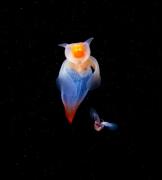ออฟไลน์ด้วยแอป Player FM !
Sea Angels
Fetch error
Hmmm there seems to be a problem fetching this series right now.
Last successful fetch was on May 19, 2024 05:25 (
What now? This series will be checked again in the next day. If you believe it should be working, please verify the publisher's feed link below is valid and includes actual episode links. You can contact support to request the feed be immediately fetched.
Manage episode 416490580 series 1022694

Some tiny sea snails may look like angels, but they act more like little devils. They rip their favorite prey from their shells. And the prey just happens to be a relative.
Sea angels are found around the world, from the arctic to the tropical waters near the equator. Most range from the surface to depths of a couple of thousand feet, although some have been seen more than a mile down.
Sea angels are born with shells, but they lose them as they become adults. They’re no more than a couple of inches long, and they have streamlined bodies. They’re mostly transparent, which helps them hide from predators. The Antarctic sea angel has extra protection: it produces a nasty chemical that keeps most predators away.
What gives sea angels their “angelic” appearance is a pair of wings. They’re adapted from the muscular foot of their land-based cousins. The creatures move through the water by flapping those wings. They can move twice as fast as their prey.
Their favorite treat is another sea snail—the sea butterfly. Some angels lie in wait, while others are more active hunters. They grab their prey with small tentacles that extend from the head. Hooks allow them to pull the butterfly from its shell in as little as two minutes.
Sea angels and their prey are jeopardized by climate change, which makes the oceans more acidic—a hazard for any creature that produces a shell. That’s an extra challenge for these angelic little devils flapping through the world’s oceans.
113 ตอน
Fetch error
Hmmm there seems to be a problem fetching this series right now.
Last successful fetch was on May 19, 2024 05:25 (
What now? This series will be checked again in the next day. If you believe it should be working, please verify the publisher's feed link below is valid and includes actual episode links. You can contact support to request the feed be immediately fetched.
Manage episode 416490580 series 1022694

Some tiny sea snails may look like angels, but they act more like little devils. They rip their favorite prey from their shells. And the prey just happens to be a relative.
Sea angels are found around the world, from the arctic to the tropical waters near the equator. Most range from the surface to depths of a couple of thousand feet, although some have been seen more than a mile down.
Sea angels are born with shells, but they lose them as they become adults. They’re no more than a couple of inches long, and they have streamlined bodies. They’re mostly transparent, which helps them hide from predators. The Antarctic sea angel has extra protection: it produces a nasty chemical that keeps most predators away.
What gives sea angels their “angelic” appearance is a pair of wings. They’re adapted from the muscular foot of their land-based cousins. The creatures move through the water by flapping those wings. They can move twice as fast as their prey.
Their favorite treat is another sea snail—the sea butterfly. Some angels lie in wait, while others are more active hunters. They grab their prey with small tentacles that extend from the head. Hooks allow them to pull the butterfly from its shell in as little as two minutes.
Sea angels and their prey are jeopardized by climate change, which makes the oceans more acidic—a hazard for any creature that produces a shell. That’s an extra challenge for these angelic little devils flapping through the world’s oceans.
113 ตอน
ทุกตอน
×ขอต้อนรับสู่ Player FM!
Player FM กำลังหาเว็บ




